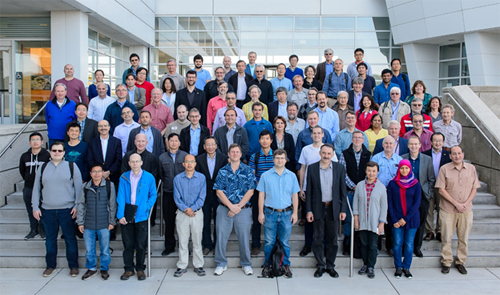 Accelerator scientists and engineers from U.S. Department of Energy (DOE) national laboratories, universities, and other research laboratories gathered for an Electron-Ion Collider (EIC) Accelerator Collaboration Meeting at the U.S. DOE’s Argonne National Laboratory Advanced Photon Source (APS) on October 9-11, 2019. The purpose at hand was to discuss the technological and design challenges common to the varied proposals for an EIC, a multi-billion-dollar accelerator project that represents the future of particle accelerators for fundamental research into the nature of matter.
Accelerator scientists and engineers from U.S. Department of Energy (DOE) national laboratories, universities, and other research laboratories gathered for an Electron-Ion Collider (EIC) Accelerator Collaboration Meeting at the U.S. DOE’s Argonne National Laboratory Advanced Photon Source (APS) on October 9-11, 2019. The purpose at hand was to discuss the technological and design challenges common to the varied proposals for an EIC, a multi-billion-dollar accelerator project that represents the future of particle accelerators for fundamental research into the nature of matter.
The meeting attendees shared a common interest in EIC accelerator design work and the development of related technologies. The group reviewed the present status of accelerator designs and exchanged recent developments and technical solutions with the goal of establishing a firmer collaboration and improved coordination of efforts towards a cost-effective and high-performance EIC accelerator design.
In the simplest terms, an EIC is a type of particle accelerator/collider designed to collide beams of electrons and ions in order to study the properties of nuclear matter in detail via deep inelastic scattering. In the case of the US proposals, the two colliding beams will be highly polarized. In 2015, the DOE Nuclear Science Advisory Committee named the construction of an electron–ion collider one of the top priorities for the near future in nuclear physics in the United States. (https://www.phy.anl.gov/nsac-lrp/) The National Academies of Sciences, Engineering, and Medicine in a 2018 report, “An Assessment of U.S.-Based Electron Ion Collider Science,” noted that a high-energy, high-luminosity EIC with highly-polarized electron and ion beams “would be unique to greatly further our understanding of visible matter.” According to Physics World (26 July 2018), the report called for a U.S.-led effort to “begin planning a next generation electron-ion collider to study the structure of protons and neutrons in unprecedented detail.” “The EIC will be the most challenging collider ever built in the US and will require the collaboration and accelerator expertise of the entire country to be successful,” said John Byrd, APS Accelerator Systems Division Director.
As described on the Brookhaven National Laboratory web site, the EIC “will be a discovery machine for unlocking the secrets of the ‘glue’ that binds the building blocks of visible matter in the universe.” This exciting, next-generation particle accelerator “collides electrons with protons and nuclei to produce snapshots of those particles’ internal structure—like a CT scanner for atoms. The electron beam would reveal the arrangement of the quarks and gluons that make up the protons and neutrons of nuclei. The force that holds quarks together, carried by the gluons, is the strongest force in nature. An EIC would allow us to study this ‘strong nuclear force’ and the role of gluons in the matter within and all around us.” (https://www.bnl.gov/eic/)
The Jefferson Lab web site describes the EIC as a “machine for delving deeper than ever before into the building blocks of matter, so that we may better understand the matter within us and its role in the universe around us. Compared to the complexity that we observe in our world, protons and neutrons may seem like simple objects, but they aren’t. Inside them is a teeming microcosm of quarks and glue-like gluons whose ethereal interactions help establish their essential properties. And while we know the fundamental constituents of protons and neutrons are quarks and gluons, we know little about how these tiniest building blocks are arranged and interact. To probe the intricacies of these inner microcosms, nuclear physicists hope to build an EIC —a machine that would open a new window through which we can study and understand the matter within us and its role in the universe around us.” (https://www.jlab.org/eic/)
Across the Atlantic, the web site for CERN, the European high-energy physics lab, notes that “the versatile EIC will, for the first time, be able to systematically explore and map out the dynamical system that is the ordinary quantum chromodynamics bound state, triggering a new area of study. Just as the advent of x-ray diffraction a century ago triggered tremendous progress in visualizing and understanding the atomic and molecular structure of matter, and as the introduction of large-scale terrestrial and space-based probes in the last two to three decades led to precision observational cosmology with noteworthy findings, the EIC is foreseen to play a similarly transformative role in our understanding of the rich variety of structures at the subatomic scale.” (https://cerncourier.com/a/electron-ion-collider-on-the-horizon/)
The Advanced Photon Source is a U.S. DOE Office of Science User Facility operated for the DOE Office of Science by Argonne National Laboratory under Contract No. DE-AC02-06CH11357.
Argonne National Laboratory seeks solutions to pressing national problems in science and technology. The nation's first national laboratory, Argonne conducts leading-edge basic and applied scientific research in virtually every scientific discipline. Argonne researchers work closely with researchers from hundreds of companies, universities, and federal, state and municipal agencies to help them solve their specific problems, advance America's scientific leadership and prepare the nation for a better future. With employees from more than 60 nations, Argonne is managed by UChicago Argonne, LLC, for the U.S. DOE Office of Science.
The U.S. Department of Energy's Office of Science is the single largest supporter of basic research in the physical sciences in the United States and is working to address some of the most pressing challenges of our time. For more information, visit the Office of Science website.
